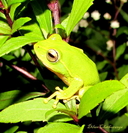|
Pseudophilautus stuarti (Meegaskumbura & Manamendra-Arachchi, 2005)
Stuart's Shrub Frog | family: Rhacophoridae subfamily: Rhacophorinae genus: Pseudophilautus |
| Species Description: Meegaskumbura M & Manamendra-Arachchi K 2005 Description of eight new species of shrub frogs (Ranidae: Rhacophorinae: Philautus) from Sri Lanka. Raffles Bull Zool Suppl 12:305-338. | |
 © 2014 Dilan Chathuranga (1 of 10) |
|
|
|
Description In life, the dorsum is light green with ashy green, ashy yellow or black dots. Tympanum, tympanic region and loreal region are green. Upper, lower lips, supratympanic fold and canthal edges are yellow. Limbs and digits dorsally yellow and ventrally "ashy yellow". Mid-flank, chin and chest are yellow. Abdomen and area around vent are "ashy flesh colour". Granules on abdomen are white. Anterior and posterior thigh is brown (Meegaskumbura & Manamendra-Arachchi 2005). Distribution and Habitat Country distribution from AmphibiaWeb's database: Sri Lanka
Life History, Abundance, Activity, and Special Behaviors Larva Possible reasons for amphibian decline General habitat alteration and loss Comments This species is named after Dr. Simon Nicolas Stuart, former Acting Director General of IUCN (2000-2001). He is known for establishing international conservation projects through worldwide biodiversity studies especially on threatened species. He also led the development of the new IUCN Red List categories as head of the Species Survival Commission (1991-2000) (Meegaskumbura & Manamendra-Arachchi 2005). The sister species of Pseudophilautus stuarti is Pseudophilautus viridis. These two species have a mtDNA sequence divergence of 6.6% which separates them from each other. P. viridis occurs on the peaks of the Central Hills at above 1,000 m while P. stuarti is restricted to the Knuckles Mountain Range at about 1,245 m. They are separated from each other by the Mahaweli River valley at about 500 m at Kandy (Meegaskumbura & Manamendra-Arachchi 2005).
References
Meegaskumbura M. & Manamendra-Arachchi K. (2005). ''Description of eight new species of shrub frogs (Ranidae: Rhacophorinae: Philautus) from Sri Lanka.'' Raffles Bulletin Zoology Supplemental, 12, 305-338. [link] Originally submitted by: Dayupathi Eranda Nipunika Mandawala (first posted 2020-12-22) Edited by: Michelle S. Koo (2022-08-18) Species Account Citation: AmphibiaWeb 2022 Pseudophilautus stuarti: Stuart's Shrub Frog <https://amphibiaweb.org/species/6519> University of California, Berkeley, CA, USA. Accessed Nov 12, 2024.
Feedback or comments about this page.
Citation: AmphibiaWeb. 2024. <https://amphibiaweb.org> University of California, Berkeley, CA, USA. Accessed 12 Nov 2024. AmphibiaWeb's policy on data use. |



 Map of Life
Map of Life